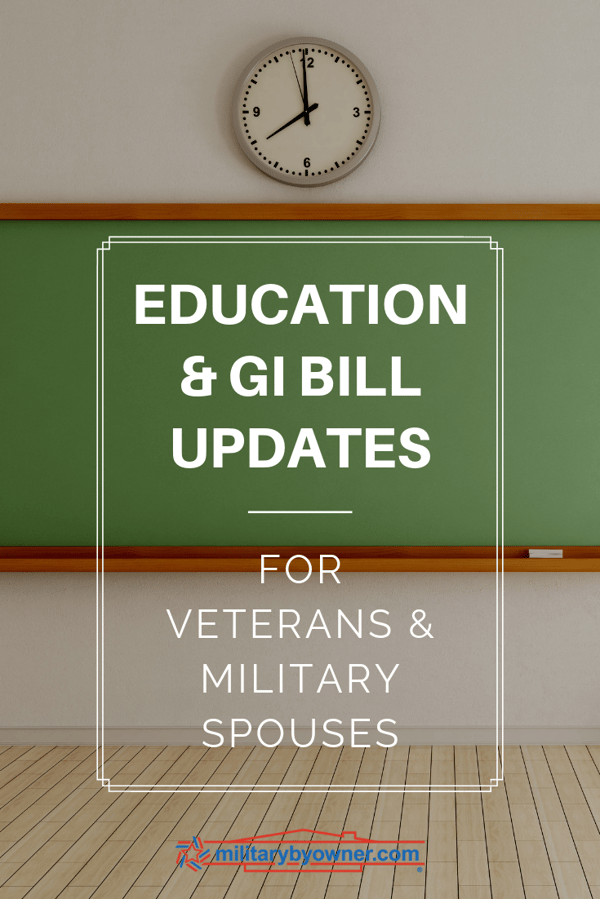Important Education and GI Bill Updates for Veterans and Military Spouses


Has the back to school energy in the air have you thinking about heading back into the classroom yourself?
It's hard not to get wrapped up in the possibilities of what the next level of education could mean for you! A bump in salary, a finished degree, or a change in industry are all some of the reasons to go back to school, but so many veterans and military spouses are deterred by the cost of education today.
In April 2019, Forbes reported that there are more than 44 million borrowers in the U.S. who together owe $1.5 trillion in student loans; that's equal to around $30,000 per student in 2017. Only mortgage debt runs higher in America.
These numbers are enough to erase any thought of enrolling again! But, wait, not so fast! One of the perks of military service is access to the GI Bill. Its sole purpose is to put veterans and their family members in school to create promising futures.
A Back-to-School Update for Military Spouses and Veterans
The History and Evolution of the GI Bill

The 75th anniversary of the first GI Bill occurred this summer, so it's a good time for a refresher on the history of the GI Bill. Let’s take a look at its origins to realize how much it's changed from its original inception back in 1944.
President Franklin D. Roosevelt signed the first iteration of the GI Bill, but its official name was the Servicemen’s Readjustment Act of 1944. The intention was to boost the American middle class returning from WWII by offering education and home loan opportunities. The program was well received, and college admissions boomed through the years before 1956 when the GI Bill was officially terminated.
It wasn’t until 1984 that the GI Bill was brought back into legislation by Congressman Montgomery. His efforts brought forth the Montgomery GI Bill. Of course, military service changed significantly after 9/11. To accommodate those changes, Senator Jim Webb submitted his version of the GI Bill--the Post 9/11 GI Bill in 2008.
Recent versions include the GI Bill 2.0 in 2010, and the Forever GI Bill in 2017, under the name The Harry W. Colmery Veterans Education Assistance Act. Colmery is credited with creating the original version of the GI Bill back in 1944.
Related article - After Military Retirement: Back To School?
The Latest GI Bill Changes
Take note, active duty members, veterans, and dependents, the Forever GI Bill was significantly upgraded to add flexibility to when and how its recipients could obtain further education. Some of the updates have been implemented, yet others will take effect in 2020-2022.

The following points highlight larger changes to the bill, not the full descriptions or entitlements.
- The expiration date of the Post 9/11 GI Bill was always a weak spot in the legislation. Previously, the veteran had to use their benefit within 15 years of their last 90-day period of active duty. This is no longer true and applies to those who transitioned out of the military after January 1, 2013. Spouses who took part in the Marine Gunnery Sergeant John David Fry Scholarship do not incur an expiration date, either.
- Purple Heart awardees are now eligible to receive all of the benefits stated in the Post-9/11 GI Bill. They were previously required to have served three years.
- The Yellow Ribbon Program was expanded. It now serves surviving spouses and children. Active duty servicemembers are slated to be eligible in August 2022. The Yellow Ribbon Program helps close the gap between costs not covered by the GI Bill and the school’s expenses. It is a voluntary partnership between the VA and participating schools that aims to reduce the amount of money paid by the student.
- The latest version of the GI Bill takes into account the specialty requirements of STEM degrees, which often take longer to earn. On a first come, first served basis, scholarships of up to $30,000 are available to servicemembers or their surviving family members. Dependents who have transferred benefits are not eligible.
- The transference of the GI Bill from the servicemember to a dependent has long been one of the biggest perks for military members, but it was lacking as it pertained to circumstances beyond death. The bill now accounts for a dependent's death and the ability for the servicemember to transfer the remaining eligibility to another dependent, retroactive to 2009. Another change allows the dependents of a deceased servicemember the opportunity to alter the distribution of benefits after the servicemember’s death. In earlier versions, the servicemember was the only one authorized to make changes.
- Those who enroll in the Survivors’ and Dependents’ Educational Assistance Program have had their monthly education allowance increased by $200, but the length of time to use the assistance was shortened from 45 months down to 36 months.
- Thousands of veterans used their GI Bill to attend schools that have since gone out of business. If their credits did not transfer to an accepting school, they were out of options, because they could not be refunded for paid credits. Now, those veterans can reclaim their education benefits. Students enrolled as far back as January 2015 are qualified.
- August 2020 starts the VA’s new measurement for GI Bill eligibility. The bill currently states that servicemembers with at least 90 days but less than six months on active duty are eligible for up to 40 percent of the full GI Bill benefits. This changes to 50% next year, accommodating more Reservists than ever before.
- Reservists and the National Guard have improved access to the GI Bill. Both groups can now include time receiving medical treatment or recovery from injuries toward their GI Bill eligibility if they were activated after 9/11. Those students who in 2015 lost the Reserve Educational Assistance Program are now allowed to credit their service under The Forever GI Bill.
- The most recent changes to the GI Bill allow Reservists to receive prorated housing allowances for any month they are activated. Older versions of the bill did not prevent the loss of a whole month’s worth of payment.
- Housing stipends are a substantial asset within the GI Bill, but they were decreased by 1% during the last rounds of changes. In order to pay for all of the other changes, a reduction was made to the allowances of stipends. Those who apply for the GI Bill after 2018 are allowed the amount active duty members earn at the E-5 with dependents rate.
- A second change to the stipend revolves around the location of the student’s school. Previously, the zip code of the school was used for housing calculations, but now it is the location where the student attends the majority of the classes.
These are the major changes made to the GI Bill, starting in 2017.
For more details, the best place to research is the VA online. The vast majority of schools have a Financial Aid and/or Student Veterans office. Be sure to check their website for specifics or to make an appointment to talk with a counselor to fully understand your educational benefits.
Military Spouse Education Resources

According to these changes, military spouses and dependents have more flexibility to find an educational path that works for their situation, but it's common for spouses to need more opportunities to find financial help for school. After you’ve considered all of the possibilities the GI Bill offers, it's time to check into alternative programs designed with military spouses in mind.
- Start with your spouse’s branch. Each has at least one program to help military spouses further their education. For example, the Army Emergency Relief Spouse Education Assistance Program, Navy-Marine Corps Relief Society Education Assistance Program, Coast Guard Mutual Assistance Supplemental Education Grants.
- Research military friendly organizations who offer scholarships, such as the National Association for Uniformed Services Scholarships, Joanne Holbrook Patton Military Spouse Scholarship Program offered through the National Military Family Association, and ThanksUSA.
- Federal and state programs are available. One of the most well-known is My Career Advancement Account Scholarship Program, or MyCAA. But, standard federal aid through the U.S. Department of Education is available through loans. Your state may also have education assistance that are either need based or loans.
- More and more, individual colleges are recognizing the sacrifices military spouses make and have begun offering tuition assistance and scholarships to help further their educational goals. Leading the way is The Veterans Career Transition Program (VCTP) through the Institute for Veterans and Military Families at Syracuse University. Many other programs are following suit. Check in with your preferred campus’s financial aid office for any financial aid offered to military spouses.
The educational opportunities for servicemembers, veterans, and dependents are more accessible than ever, thanks to the GI Bill and the increasing awareness throughout the public about the educational needs of a military family. Don’t let your kids be the only ones who go back to school! Take advantage of the programs created just for you and begin mapping out the next years of your future.
Did you know that the initial versions of the GI Bill also included access to the VA Loan program? From its inception, right on up to today, veterans have been taking advantage of one of the best advantages in the military. MilitaryByOwner can help you decide if the VA Loan is a good choice for your home loan. Check out our home financing resources to learn more.






